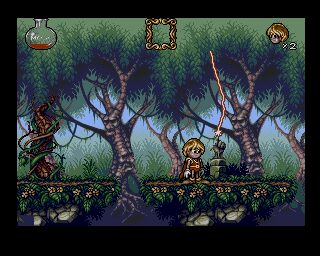Switchblade is a side-scrolling action-platformer released in 1989 by Gremlin Graphics and designed by Simon Phipps.
It was developed for the Atari ST before being ported to other platforms, including the Amiga, Amstrad CPC, Commodore 64, ZX Spectrum, and even later to consoles like the Sega Mega Drive in some regions. Combining exploration, combat, and puzzle-solving, the game stood out as an atmospheric and challenging game that pushed the capabilities of the hardware it was developed for.
The game is set in the dystopian world of Thraxx, where the sacred Fireblade has been shattered by the evil Havoc, allowing darkness to spread across the land. Players take control of *Hiro*, the last surviving *Blade Knight*, on a mission to recover the lost fragments of the Fireblade and defeat Havoc. Unlike many platformers of the time, Switchblade emphasizes non-linear exploration, requiring players to carefully traverse the underground labyrinth of interconnected rooms while searching for weapons, upgrades, and hidden paths.
One of the most striking aspects of the game is its fluid animation, especially in the Atari ST and Amiga versions. Simon Phipps, known for his distinctive art style, created a detailed and atmospheric world with smooth character movement ahead of its time. The Amiga version, in particular, benefits from an expanded color palette and superior sound, enhancing the overall presentation. While simple in principle, the gameplay—punching enemies, dodging traps, and collecting Fireblade fragments—demands precision and patience due to its methodical pacing and enemy placement. Unlike many fast-paced action games of the era, Switchblade requires careful maneuvering and tactical combat rather than pure reflex-based gameplay.
The ports of the game vary significantly in quality. The Atari ST and Amiga versions are the most polished, featuring detailed graphics and fluid scrolling. The Amstrad CPC and ZX Spectrum versions, while technically impressive for 8-bit systems, suffer from limited colors and slower performance. The Commodore 64 version, though more colorful than the Spectrum release, struggles with sprite flickering and less responsive controls. Later console adaptations tweaked certain mechanics but retained the core exploration-heavy gameplay.
Upon release, Switchblade was well received, praised for its detailed visuals, smooth animations, and engaging level design. Critics particularly appreciated its blend of action and adventure, distinguishing it from more straightforward arcade-style platformers. However, some players found the pacing too slow compared to more immediate and fast-paced action games. The game was followed by Switchblade II in 1991.








